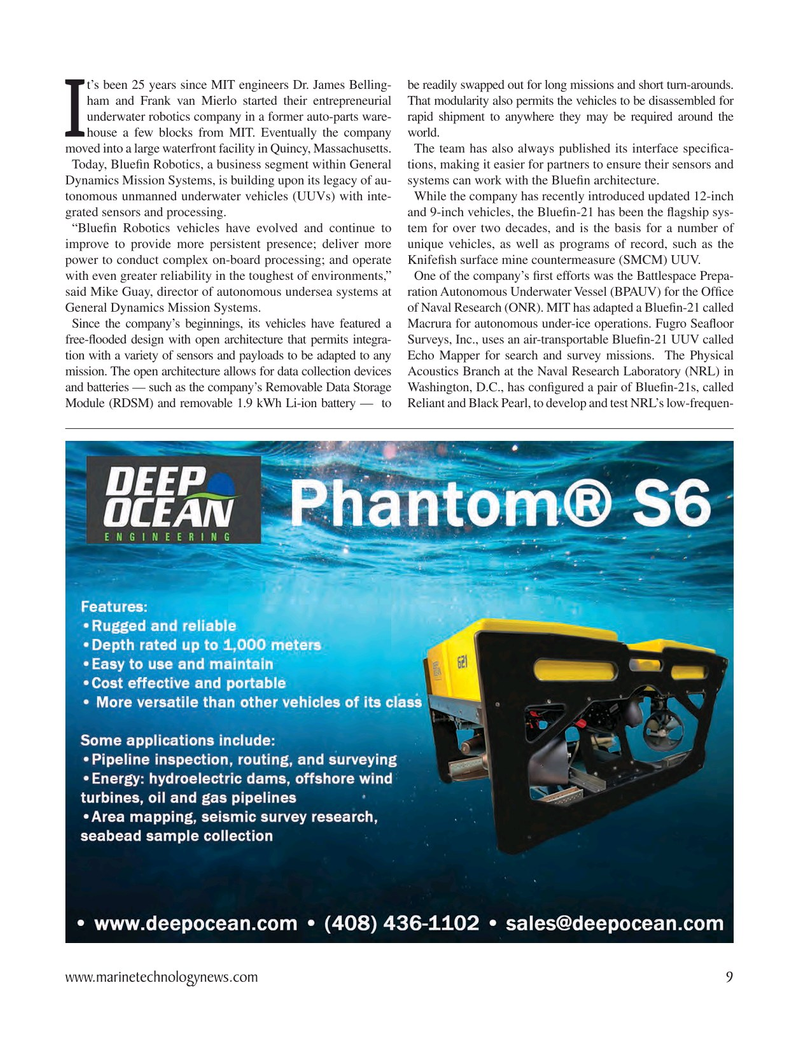
Page 9: of Marine Technology Magazine (May 2023)
Read this page in Pdf, Flash or Html5 edition of May 2023 Marine Technology Magazine
t’s been 25 years since MIT engineers Dr. James Belling- be readily swapped out for long missions and short turn-arounds. ham and Frank van Mierlo started their entrepreneurial That modularity also permits the vehicles to be disassembled for underwater robotics company in a former auto-parts ware- rapid shipment to anywhere they may be required around the
Ihouse a few blocks from MIT. Eventually the company world.
moved into a large waterfront facility in Quincy, Massachusetts. The team has also always published its interface speci? ca-
Today, Blue? n Robotics, a business segment within General tions, making it easier for partners to ensure their sensors and
Dynamics Mission Systems, is building upon its legacy of au- systems can work with the Blue? n architecture.
tonomous unmanned underwater vehicles (UUVs) with inte- While the company has recently introduced updated 12-inch grated sensors and processing. and 9-inch vehicles, the Blue? n-21 has been the ? agship sys- “Blue? n Robotics vehicles have evolved and continue to tem for over two decades, and is the basis for a number of improve to provide more persistent presence; deliver more unique vehicles, as well as programs of record, such as the power to conduct complex on-board processing; and operate Knife? sh surface mine countermeasure (SMCM) UUV. with even greater reliability in the toughest of environments,” One of the company’s ? rst efforts was the Battlespace Prepa- said Mike Guay, director of autonomous undersea systems at ration Autonomous Underwater Vessel (BPAUV) for the Of? ce
General Dynamics Mission Systems. of Naval Research (ONR). MIT has adapted a Blue? n-21 called
Since the company’s beginnings, its vehicles have featured a Macrura for autonomous under-ice operations. Fugro Sea? oor free-? ooded design with open architecture that permits integra- Surveys, Inc., uses an air-transportable Blue? n-21 UUV called tion with a variety of sensors and payloads to be adapted to any Echo Mapper for search and survey missions. The Physical mission. The open architecture allows for data collection devices Acoustics Branch at the Naval Research Laboratory (NRL) in and batteries — such as the company’s Removable Data Storage Washington, D.C., has con? gured a pair of Blue? n-21s, called
Module (RDSM) and removable 1.9 kWh Li-ion battery — to Reliant and Black Pearl, to develop and test NRL’s low-frequen- www.marinetechnologynews.com 9
MTR #4 (1-17).indd 9 5/31/2023 3:43:53 PM

 8
8

 10
10
